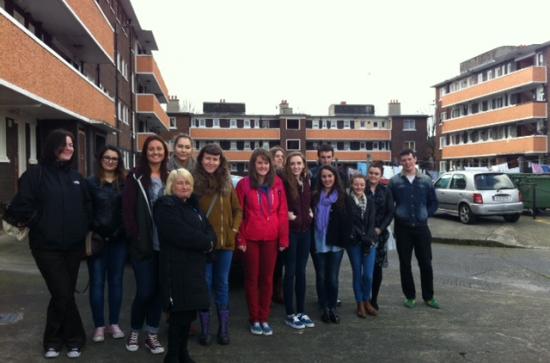
2nd Year Geography Human Rights and Spatial Justice class field trip to inner-city Dublin community
April 13th, 2014
Report on the trip by Niamh Cotter, 2nd year Geography Student
Debbie is the community worker in Dolphin House that met us when we arrived. She led us to their community centre and gave a presentation about the violations of Human Rights experienced by Dolphin House residents. Debbie has been living for 3 generations in Dolphin House and has grandchildren now living there. She informed us that there are 392 flats with 1,2 or 3 bedrooms. 900 people live in Dolphin house, with 44 senior citizens and over 100 children. Debbie and some other residents have had some training on human rights through a Community Action Network. This has enabled the community to have their voice heard in order to exercise their rights and effect change. Some of the residents took a course to learn how to talk to the media in order to maintain control of the interviews held with Dolphin house tenants. In this way they could steer the conversation towards upholding the rights of the tenants and thereby address the myriad of problems they face. These include damp and mold on internal walls and sewage backing up the pipes only to resurface in sinks and bathtubs.
Dublin City Council, the housing authority, allegedly blamed the residents for sewage backing up the pipes, stating they are throwing nappies down the toilets. In actual fact, upon closer inspection, ie pumping the waste water pipes, they discovered this was the first time they had been cleaned since the flats were constructed in the 1950’s. The community had some of the damp and mold scientifically analysed and discovered pathogenic spores which have a direct impact on their health.
Aside from health issues, these conditions impact the community in other negative ways. Almost 50% of children and more than 50% of adults suffer from respiratory problems such as asthma. Following a survey they discovered that 92% of children were missing school as a result of health implications. Rent for these unmaintained properties is based upon earnings. A tenant on social welfare may pay €25 a week, while a working tenant can pay up to €100 per week. This rent for an unhealthy living environment where the authorities blame the local people for their situation is not a helpful way to improve their situation.
Within the community centre there is a music room for the children, a communal kitchen where each Thursday the residents are invited for a free healthy breakfast, and a homework room for the children to receive assistance. Within the hall of the community centre they stage plays and other events for the community by the community. We left the community centre and walked around the grounds passing a football field in the middle of the estate.
We passed a row of trees with colourful flowers lining the terraced housing where senior citizens may request to be relocated to, although the age is only 55 to move in. Here they have individual bedsits and a common room where they may sit together to enjoy their meals together. They also have a communal kitchen where the cooking is done for them by the local community project.
We then walked through the estate, passing the blocks of flats and entered one of them. Here the function has changed from residential to administration and Tony sits there, a Dublin City Council employee. His job is to take complaints about the quality of housing from the residents. Debbie told us more than 50 flats have been renovated while his figure was more than 70. All in all, his presence has seen some changes happening.
Empowering the community has had a hugely positive impact on the residents of Dolphin House and has mobilized some of the tenants who may not have complained otherwise. Now that they see their voice is being heard, they are exercising their rights like any other Irish citizen should. Both their voices, combined with their Human Rights, have agency. Although there are problems still existing since the 1970’s, the residents are keeping the pressure on in order to continuously improve their homes.
One of the most striking aspects of our trip to Dolphin House was the strong sense of community in the neighbourhood. It was much more visible than it is in housing estates and apartment blocks. Here the people have several generations living in Dolphin House so they appear to be much like a big family. They take care of each other. I wondered about senior citizens and those with disabilities living in rural Ireland, not having such a community to aid and assist one another. They have empowered themselves to have their rights, dignity and integrity upheld, a lesson within a community which we could all learn something from.
